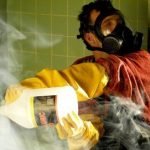It’s been a while ever since we did some scientific breakdown of something almost all the mainstream media has been screaming about. The beauty of Breaking Bad lies in the underlying honesty of the show. Chemistry as a science of change. Change that happens to every character in the series. This article, however, is about the little bits of actual chemical tricks Walter displays as Heisenberg. Breaking down the badass scenes of the show is just an added perk.
Exploding crystals
In Breaking Bad, Walt is a high school chemistry teacher turned criminal producing amphetamine (crystal meth) to sell on the black market. At one point his partner, Jesse, gets swindled and beaten up by a psychopathic gangster called Tuco. Walt confronts Tuco and offers him some more crystals but insists on being paid immediately. Tuco starts to get nasty … but Walt has a plan.
In anticipation of the negotiations not going to plan, Walt hasn’t actually given Tuco a bag of crystal meth but in fact crystals of ‘fulminate of mercury’ – a high explosive! He throws a crystal on the ground which detonates creating an almighty explosion. In the last scene, we see Walt walking victoriously from the smoking remains of Tuco’s office clutching a bag of money!
Could a small crystal of mercury fulminate really do so much damage? Mercury fulminate (or fulminate of mercury, as Walt rightly calls it) Hg(ONC)2 is a very unstable and explosive compound. Although first prepared back in 1800, because of its instability the crystal structure was only fully determined as recently as 2007. It is prepared by reacting mercury with nitric acid and then adding ethanol. The crystals are usually brown to grey (due to colloidal mercury) and large crystals are extremely unstable.
Silver fulminate can also be prepared in a similar way but is too sensitive for commercial use, though some crackers and children’s toy caps (eg Fun Snaps) sometimes make use of it.
Pressure changes, vibrations and shock can lead to detonation. The explosive properties can be demonstrated in the lab by hitting a very small crystal (ca. < 1 mm3) with a hammer. Detonation produces mercury vapour, carbon monoxide and nitrogen.
One explosion pathway could be:
Hg(ONC)2 → Hg + 2CO + N2
Walt’s crystals are transparent and 1000 times larger than the demonstration crystals mentioned above. If they could have been prepared at all without detonation they would have been very unstable to carry around but could indeed have created a very powerful explosion. Also, the shock wave would no doubt have detonated the other crystals in the bag on Tuco’s desk. I doubt there would have been such a great quantity of flames issuing from the explosion as you see in the film.
Had Walt and Tuco survived the explosion, they would not have been able to hear for a long while!
Poison Gas
Things go wrong when two rival gangsters threaten to kill them. Bargaining for his life Walter takes them into the lab promising to show them how to make top-grade meth.
Thinking on his feet he starts the process but manages to contrive a reaction to produce poisonous gas to kill the gangsters. He heats up a pan of water and when it’s boiling throws in a bottle of red phosphorus. A shower of sparks causes enough confusion for White to escape outside where he holds the door shut trapping the two gangsters in the fumes and poisonous gasses.
Later Walter explains to Jesse “red phosphorus in the presence of moisture and accelerated by heat yields phosphorus hydride … phosphine gas … one good whiff and …”.
It’s a clever way of getting out of a tight spot but is the chemistry correct?
Not all phosphorus is the same Phosphorus does indeed react with water vapor to produce phosphine (PH3), a colorless, flammable and toxic gas (b.p. -87°C, dangerous level ca. 50 ppm in air).
However, the standard industrial reaction requires white phosphorus, rather than red, and concentrated sodium hydroxide:
P4 + 3NaOH + 3H2O → 3NaH2PO2 + PH3
Phosphine gas is reported to be a dangerous byproduct in the illicit production of ‘meth’ so this may be where the idea came from in the program. Red and white phosphorus are allotropes, with white phosphorus existing as P4 molecules and red phosphorus as an amorphous network. White is much more reactive than red phosphorus and can be heated to make the red allotrope, which can then be purified with hot water. Heated red phosphorus can react with hydrogen to make PH3 but Walter only has steam.
As it’s definitely red phosphorus that Walter is using the chemistry is not looking too good. He did heat the pan over a camping gas stove and so the sparks could have been some of the phosphorus burning in the flame (red P burns above 260°C in air) but simply adding red phosphorus to a frying pan of steaming boiling water would not produce the clouds of phosphine gas we see in the show.
Acid Bath
In a previous episode, they found themselves in a tight spot with gangsters who forced them to make drugs. He improvised an experiment to gas them but now they have the problem of disposing of the bodies. Walter suggests using acid, but this has problems of its own.
Walter knows that an acid such as hydrofluoric acid (HF) will be able to dissolve the bodies as it can destroy tissue and decalcify bone, so he steals a few large bottles of HF from his high school chemical stores. He tells Jesse that they need to be careful about the type of container they use to put the bodies in as HF is so dangerous it can react with metals, certain plastics, and even glass. He sends Jesse off to the local hardware store to find something suitable.
Hiding behind the shop shelves, Jesse tries sitting in plastic crates to find out which would be large enough. He soon gets annoyed and frustrated and so just goes home. Jesse places the first body in his household bath and, whilst wearing gloves and a face mask, adds the acid. When the two next meet up at the end of the day, the acid has eaten through the bottom of the bath and they arrive just in time to witness the floorboards give way, releasing all the ghastly contents onto the corridor below!
HF used to be stored in wax bottles but nowadays polyethylene or Teflon (PTFE) bottles are used. So you really do need the correct type of plastic container and you definitely wouldn’t want to use a standard household bath.
In the show, Jesse wears a face mask and gloves. HF eats through most types of gloves and can easily penetrate the skin and fat tissue. Once it is in the bloodstream it will quickly act as a poison. The fumes from the many liters of HF that Jesse was exposed to would have been deadly. A single lungful would cause so much fluid on his lungs, he would have drowned.
A real case
Perhaps the most famous real-life acid bath criminal case involved John George Haigh. When police arrested him he told them that ‘Mrs. Durand-Deacon no longer exists, I’ve destroyed her with acid. You can’t prove murder without a body’. He went on to admit to eight other murders where he disposed of the body in sulfuric acid baths. Police eventually found remains which had been reduced to sludge but gallstones and part of a plastic denture survived, confirming the woman’s identity. Haigh was eventually hanged for his crimes in 1949.
Thermite break-in
Their starting material for the crystal meth is an over-the-counter drug from the pharmacist. Unfortunately, the pharmacist is only legally allowed to sell a couple of packets to one person, so Jesse has to organize a whole host of ‘Smurfs’ (‘dudes’ prepared to go into loads of pharmacists) to go out and collect enough.
To bypass this obvious limitation, Walt suggests an alternative precursor which they have to steal from a lockup. They burn out the security lock using a thermite reaction and in a very humorous clip, reminiscent of a scene from Laurel and Hardy, they make away with a large drum. Afterward, the local drug squad watch the CCTV footage and enjoy laughing at their antics – carrying the drum rather than rolling it along.
In the show, Walt enthusiastically describes the basic chemistry of the thermite reaction to Jesse – something that doesn’t happen very often in a Hollywood film!
The thermite is a classic reduction-oxidation reaction. Iron oxide and aluminum powder are often used:
Fe2O3 + 2Al → Al2O3 + 2Fe
The further apart the two metals are in the electrochemical series, the faster and more furious the reaction.
The thermite reaction is not an explosive but the energetic reaction can produce very high localized temperatures. It can be used for welding or ‘cutting’ through metals. The reaction with aluminum is particularly useful. It melts at relatively low temperatures so the reaction is easy to start. Aluminium also has a high boiling point. And so the reaction can reach very high temperatures of around 2500°C and so be used to weld railway tracks together for example.
The British army used the reaction for a variety of on-the-spot applications. In the right quantities, it is certainly capable of creating the sustained heat to melt a lock. Although, it could easily have set fire to the door and surroundings!









Leave a Reply